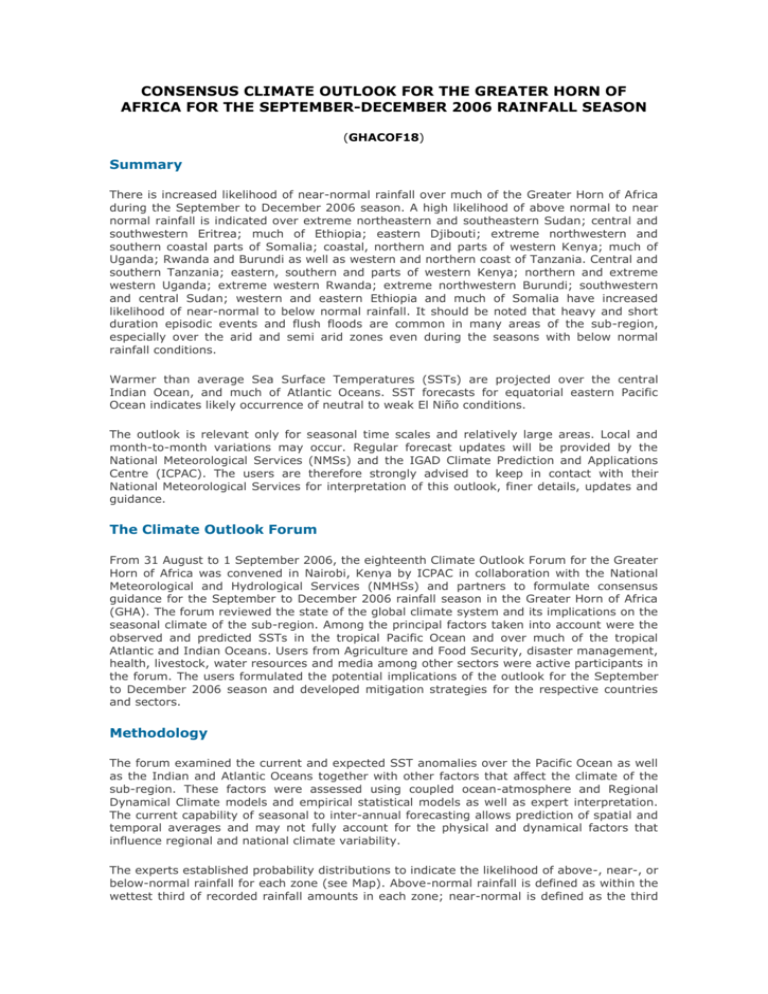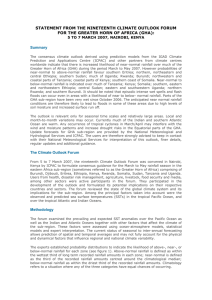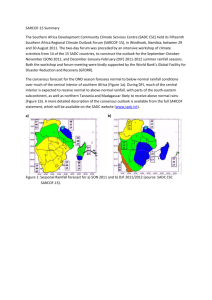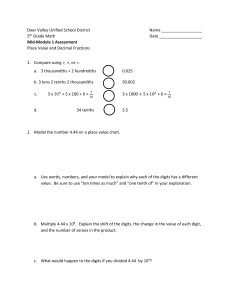CONSENSUS CLIMATE OUTLOOK FOR THE GREATER
advertisement

CONSENSUS CLIMATE OUTLOOK FOR THE GREATER HORN OF AFRICA FOR THE SEPTEMBER-DECEMBER 2006 RAINFALL SEASON (GHACOF18) Summary There is increased likelihood of near-normal rainfall over much of the Greater Horn of Africa during the September to December 2006 season. A high likelihood of above normal to near normal rainfall is indicated over extreme northeastern and southeastern Sudan; central and southwestern Eritrea; much of Ethiopia; eastern Djibouti; extreme northwestern and southern coastal parts of Somalia; coastal, northern and parts of western Kenya; much of Uganda; Rwanda and Burundi as well as western and northern coast of Tanzania. Central and southern Tanzania; eastern, southern and parts of western Kenya; northern and extreme western Uganda; extreme western Rwanda; extreme northwestern Burundi; southwestern and central Sudan; western and eastern Ethiopia and much of Somalia have increased likelihood of near-normal to below normal rainfall. It should be noted that heavy and short duration episodic events and flush floods are common in many areas of the sub-region, especially over the arid and semi arid zones even during the seasons with below normal rainfall conditions. Warmer than average Sea Surface Temperatures (SSTs) are projected over the central Indian Ocean, and much of Atlantic Oceans. SST forecasts for equatorial eastern Pacific Ocean indicates likely occurrence of neutral to weak El Niño conditions. The outlook is relevant only for seasonal time scales and relatively large areas. Local and month-to-month variations may occur. Regular forecast updates will be provided by the National Meteorological Services (NMSs) and the IGAD Climate Prediction and Applications Centre (ICPAC). The users are therefore strongly advised to keep in contact with their National Meteorological Services for interpretation of this outlook, finer details, updates and guidance. The Climate Outlook Forum From 31 August to 1 September 2006, the eighteenth Climate Outlook Forum for the Greater Horn of Africa was convened in Nairobi, Kenya by ICPAC in collaboration with the National Meteorological and Hydrological Services (NMHSs) and partners to formulate consensus guidance for the September to December 2006 rainfall season in the Greater Horn of Africa (GHA). The forum reviewed the state of the global climate system and its implications on the seasonal climate of the sub-region. Among the principal factors taken into account were the observed and predicted SSTs in the tropical Pacific Ocean and over much of the tropical Atlantic and Indian Oceans. Users from Agriculture and Food Security, disaster management, health, livestock, water resources and media among other sectors were active participants in the forum. The users formulated the potential implications of the outlook for the September to December 2006 season and developed mitigation strategies for the respective countries and sectors. Methodology The forum examined the current and expected SST anomalies over the Pacific Ocean as well as the Indian and Atlantic Oceans together with other factors that affect the climate of the sub-region. These factors were assessed using coupled ocean-atmosphere and Regional Dynamical Climate models and empirical statistical models as well as expert interpretation. The current capability of seasonal to inter-annual forecasting allows prediction of spatial and temporal averages and may not fully account for the physical and dynamical factors that influence regional and national climate variability. The experts established probability distributions to indicate the likelihood of above-, near-, or below-normal rainfall for each zone (see Map). Above-normal rainfall is defined as within the wettest third of recorded rainfall amounts in each zone; near-normal is defined as the third of the recorded rainfall amounts centred around the climatological median; below-normal rainfall as within the driest third of the rainfall amounts. Climatology refers to a situation where any of the three categories have equal chances of occurring. Outlook September to December constitutes an important rainfall season over much of the Greater Horn of Africa sub-region. The rainfall outlook for each zone within this sub-region is given below. Zone I: Increased likelihood of above to near normal rainfall over southern coast of Somalia, Kenyan coast and northern coast of Tanzania. Zone II: Increased likelihood of near to below-normal rainfall over southern, parts of central and northeastern Tanzania; southern, eastern and parts of western Kenya; northern and extreme western Uganda; extreme parts of western Rwanda; extreme northwestern Burundi; much of Somalia and eastern Ethiopia. Zone III: Increased likelihood of above to near normal rainfall over western and Lake Victoria basin parts of Tanzania; much of Rwanda and Burundi as well as much of southern and central Uganda. Zone IV: Increased likelihood of above to near normal rainfall over northern Kenya; southeastern and northeastern Sudan; southwestern, central and parts of northern Ethiopia; extreme northwestern Somalia; eastern and southern Djibouti as well as southern, central and parts of northern Eritrea. Zone V: Increased likelihood of near to below-normal rainfall over western Ethiopia, central and southwestern Sudan. Zone VI: Climatology is indicated over northern and western Djibouti; northeastern Ethiopia as well as southern and eastern Eritrea. Zone VII: Climatology is indicated over northern Sudan and western Eritrea. Note: The numbers for each zone indicate the probabilities (chances of occurrence) of rainfall in each of the three categories: above-, near-, and below normal. The top number indicates the probability of rainfall occurring in the above-normal category; the middle number is for the near normal and the bottom number for the below-normal category. For example, in case of western Ethiopia as well as central and southwestern Sudan (zone V), there is 25% probability of rainfall occurring in the above normal category; 40% probability of rainfall occurring in the near-normal category; and 35% probability of rainfall occurring in the below normal category. It is emphasized that boundaries between zones should be considered as transition areas Contributors The forum was organised by ICPAC within the framework of the United States Agency for International Development / Office of foreign disaster assistance (USAID/OFDA) funded project “Sustainable generation and application of climate information, products and services for disaster preparedness and sustainable development in the Greater Horn of Africa”. Additional support was provided by the World Meteorological Organisation (WMO), National Oceanic and Atmospheric Administration Climate Program Office (NOAA/CPO) and the International Strategy for Disaster Reduction (UN/ISDR). ICPAC's basic operations and the development of financial / administration systems are supported by USAD/East Africa. Contributors to this consensus climate outlook included representatives of the Meteorological Services from ten GHA countries (Insititut Geographique du Burundi; Meteorologie Nationale de Djibouti; Eritrea Meteorological Services; National Meteorological Services Agency of Ethiopia; Kenya Meteorological Department; Rwanda Meteorological Service; Sudan Meteorological Authority; Tanzania Meteorological Agency and Uganda Department of Meteorology) and climate scientists and other experts from national, regional and international institutions and organisations such as ICPAC; Drought Monitoring Centre, Harare; IRI; WMO; University of Nairobi and Beijing Climate centre. Additional inputs were provided by the National Centers for Environmental Prediction/Climate Prediction Center (NCEP/CPC); ECMWF; UK Met Office; USGS and FEWSNET.








